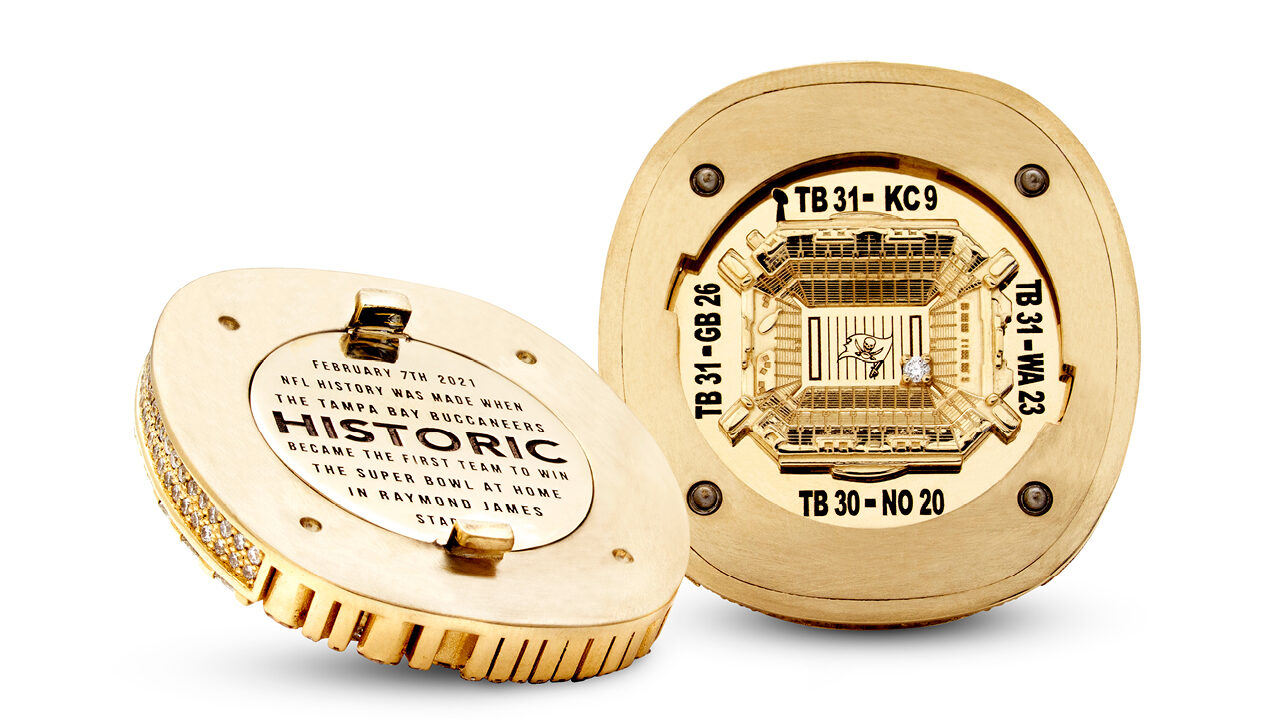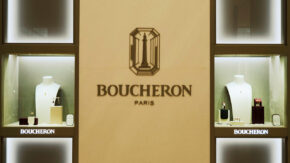The most important game of the year happens in February, and the winners take home the ultimate jewelry prize: a championship ring.
Super Bowl Sunday is practically a national holiday in the US, and it has a high-profile jewelry tie-in: The blinged-out rings that winning teams have commissioned every year since the Super Bowl’s inception in 1967.
Drawing anywhere from 50 million to 100 million TV viewers each year, this much-anticipated event has cultivated a large fan base and a thriving collectibles market. It is also an enormous marketing opportunity for companies. The game’s halftime commercials have become legendary, with brands developing big-budget ads especially for the occasion. Thirty-second commercial spots during the 2022 Super Bowl cost about $6.5 million — quite a jump from 1967, when the bill was $37,000. During the 2017 Super Bowl, Tiffany & Co. ran a 60-second ad for its HardWare line. It starred Lady Gaga, who performed during the halftime show that year.
The game has also become a red-carpet moment. Stars flock to the event as both spectators and performers, and jewelers are keen to take advantage of this high-profile exposure. At last year’s Super Bowl, Tiffany dressed halftime performer Kendrick Lamar with multiple jewels — including three vintage Schlumberger brooches — while music icon Beyoncé, who was in the audience, dripped with diamonds from Messika’s high-jewelry collections. Even the players became targets for jewelers: For Super Bowl LVI last year, design company Jason of Beverly Hills teamed up with footwear specialist The Shoe Surgeon to deck out the cleats of Los Angeles Rams wide receiver Odell Beckham Jr. in 25 carats of diamonds.
Then there’s the Super Bowl ring. Memorabilia company Jostens made the first one for the Green Bay Packers in 1967 and has since made 34 others. That first piece was relatively modest by today’s standards, containing just one diamond; over the decades, the championship ring styles have changed as much as the uniforms. While Jostens has made the majority of the rings, other jewelers have gotten the chance as well — including Tiffany, which has made seven. The job of creating last year’s ring fell to none other than Jason of Beverly Hills — a relative newcomer in this arena, but a well-known name in celebrity circles.
Tackling the design
Jason Arasheben opened Jason of Beverly Hills in February 2002. The son of a jewelry wholesaler, he would sketch out championship ring designs and other bold looks in the early stages of his business. He developed relationships with professional athletes in his area, since his aesthetics matched their own. By 2009, he was catering to many National Basketball Association (NBA) and National Football League (NFL) stars as clients, and an opportunity arose to compete for the Los Angeles Lakers NBA championship ring program. He won the bid and made the rings, paving the way for similar projects to follow.
In 2021, the jeweler — who now has five stores worldwide — earned the right to produce the Super Bowl rings for the Tampa Bay Buccaneers, who had beaten the Kansas City Chiefs. Arasheben got the gig again in 2022, this time for the Los Angeles Rams, who had won against the Cincinnati Bengals.
Securing those jobs was no easy task. Once a team wins a Super Bowl, explains Arasheben, jewelry companies woo the team to get the contract. “So the day after the game, the winning team will hear from us. We send huge gift baskets and work behind the scenes with the executives to plant the seeds. Other franchise owners may call the winning team to refer us. It’s a courting process.”
What’s worked in the jeweler’s favor for the last two Super Bowls is his relationships with the players, as they often have the final say. Another reason is the ingenuity of his designs.
“We’re competing against billion-dollar companies, but we were the first to inlay a piece of the ball from the game into a ring,” he says. “We were the first to have a removable top to reveal the stadium design, and we were the first to make a convertible ring that can [also] be worn as…a pendant.”
The design process starts like a sports fan’s dream homework assignment. Arasheben and his team research season statistics, logos, slogans, colors, and important aspects of the city, including its monuments. Then comes the storyboarding — the graphic representation of all the main bits — and a design meeting with the team, where the players dish on priorities.
“You decide key aspects of the design…and things they don’t want,” elaborates Arasheben. The Rams players, for instance, asked that he include the “We Not Me” team slogan, “because the head coach had it written on a chalkboard, and it was special to the team.”
One thing the players definitely don’t want is to go small. “They want big, over-the-top rings, as the designs become a competition. Who can make one bigger and better? Teams all try to outdo each other,” he says.
Variations on a team
Once the design is finalized, the jeweler makes three to five tiers of rings. Players, owners and coaches get ones in 14-karat gold with VS-clarity diamonds and gemstones. Further down the corporate ladder, the materials and designs can vary by as much as 15%.
“[Lower]-tier rings mimic the look and feel of the top-tier styles but are scaled down in size and made in different materials, such as sterling silver and cubic zirconia,” explains Arasheben.
The firm that lands the contract also secures the right to make and sell related trinkets, such as pins, keychains and money clips. All are available in the winning teams’ e-stores as well.
Recently, Signet Jewelers got into the Super Bowl accessory game by partnering with luxury manufacturer Renaissance Global to unveil the NFL-licensed True Fans Fine Jewelry line. Representing all 32 teams in the league, the collection features a range of styles in sterling silver and 10-karat gold with black onyx and diamonds. The plan is to add further designs for Super Bowl and Pro-Bowl games. The jewelry is available exclusively at Kay Jewelers and Zales, and retails for about $200 to $900.
Both the rings and the related merchandise can be a boon for business. Arasheben points to increased sales in all five of his locations — Los Angeles, Miami, Las Vegas, Tokyo, and Charlotte, North Carolina — because of the high-profile contracts. His Charlotte store alone has a captive high-net-worth audience. It’s in the Ritz Carlton hotel, which is “the one that all 30 NBA teams stay in,” he says.
The media buzz is a gift that keeps on giving, leading to myriad interviews on sports shows. And once the contract is signed, the countdown to the rings’ release begins. Arasheben takes to social media to promote the official date. “There is a ring ceremony on TV where the designs are unveiled, and it’s the first time that players see them.”
Making a play for her heart
Mike Berger didn’t make last year’s Super Bowl rings, but he did make an engagement ring for one of the players: Rams safety Taylor Rapp.
“It was Taylor’s idea to propose after [the team] won the Super Bowl,” explains the owner of Lippa’s Estate and Fine Jewelry in Burlington, Vermont.
Berger met an NFL agent more than 10 years ago in San Francisco, California, and that connection paved the way to meeting others — including Rapp’s agent, CJ LaBoy. When the safety told LaBoy that he wanted to propose to his high-school sweetheart, LaBoy introduced him to Berger, who had already made several engagement rings for other athletes.
“Taylor and I had been working together for a couple of weeks trying to find the perfect diamond,” relates Berger. “Once [it was] found, we discussed the ring design. Originally, he was planning to propose in February after the season, but once the Rams made the Super Bowl, Taylor contacted me and said he wanted to propose after they won — in two weeks!”
Berger hustled to get that mounting made, and did so just in time. The final product featured an elongated cushion-cut, 3-carat, colorless diamond in 18-karat yellow gold. TV cameras caught the proposal live just after the win occurred, and the media frenzy gave way to a Super Bowl-sized spotlight of Berger’s own.
“We had numerous TV stations come and interview me about the ring,” he says. “The timing was perfect and made a huge difference in coverage.”
A different kind of Super Bowl proposal event took place a few years earlier at Northeastern Fine Jewelry in New York. For Super Bowl LI, the 30-year-old retailer — which has stores in Albany, Schenectady, and Glen Falls — partnered with jewelry brand Tacori to run a contest for anyone who bought a Tacori diamond engagement ring in December 2016 and January 2017. One randomly selected winner earned a Super Bowl party for family and friends — and the opportunity to propose during the 2017 halftime show.
The winning groom popped the question in a pre-filmed ad spot that aired as he and his girlfriend watched the game from their sofa. The groom then got down on bended knee in their living room, and a local news crew filmed the live proposal.
“We sold over 100 rings,” says Northeastern vice president Gregg Kelly. “The promotion gave us a 25% boost in purchases and 50% more traffic. Plus, we had a lot of phone calls and inquiries. It was great for us from a retail perspective, and we would be open to doing it again.”
A sporting chance at auction
Football fans who weren’t born with Tom Brady-like athleticism can still acquire a Super Bowl ring, but they’ll have to buy it. Championship rings are as coveted on the secondary market as they are new. So when they go to auction, they often sell for much more than the value of the gold and diamonds they contain.
Super Bowl rings end up on the market for many reasons. Sometimes a player has passed away, and selling the ring is the most equitable way for the family to distribute the player’s assets. Other times, it may be auctioned off for charity, or to raise money for sending grandkids to college, or to offset a financial hardship like a bankruptcy. A ring owner might also sell directly to a specific collector to make sure it ends up in “a home that will cherish it,” says Scott Fitzgerald, director of sports and memorabilia for Ripley Auctions in Indianapolis, Indiana.
In February 2022, Fitzgerald’s employer auctioned off a Super Bowl XLI (2007) ring that had belonged to Indianapolis Colts linebacker Gary Brackett. The presale estimate was $10,000 to $30,000, but the ring went for much more: $75,000.
“You could have made a new one for less,” jokes Fitzgerald, “but it would not be the same as having an original.” More than 30 bidders battled to buy the piece.
Heritage Auctions in Dallas, Texas, has sold nearly 200 Super Bowl rings since the 2004 debut of its sports auctions division. At press time, the auctioneer had just sold Charles “Fuzzy” Thurston’s Super Bowl I Green Bay Packers ring for $216,000 — a record price for any ring from that team. The popular player was a starter on the offensive line in a guard position.
The most expensive championship ring Heritage ever sold was a Super Bowl V ring from 1970 that belonged to onetime Baltimore Colts head coach Donald McCafferty. It brought in $300,000 — a world record for any Super Bowl ring — in August 2022.
For sports auctions director Chris Ivy, perhaps the coolest Super Bowl ring to come through Heritage was William “Refrigerator” Perry’s from Super Bowl XX (1986). The Chicago Bears ring, which sold in 2015, was the largest Ivy had ever held: an estimated size 25. “There was no measuring tool large enough to confirm the size,” he says.
Ivy urges collectors of these rings to deal only with reputable purveyors. “There are counterfeits out there. And if someone can get a salesman’s sample Super Bowl ring, they can alter it to make it look like a real player’s ring.”
Hammer prices depend on the tier of the ring, as well as who the owner was — a player, a front-office employee, or someone else in the organization. Popularity is a factor as well; Ivy estimates that a ring from Tom Landry, the Dallas Cowboys’ first head coach, would “sell for more than any other player except [former Cowboys quarterback] Roger Staubach.” Why? “Because [Landry] is a figure who built the Cowboys from their inception in 1960 and created their winning culture.”
The Tiffany trophy
Since the first Super Bowl back in 1967, Tiffany & Co. has made the annual Vince Lombardi Trophy for the winning team. Lombardi, who led the Green Bay Packers to victory in Super Bowls I and II, is a legend in football coaching for his leadership and instructional capabilities.
Former Tiffany vice president Oscar Riedener sketched the original trophy design on a napkin during a 1966 meeting with then-NFL commissioner Pete Rozelle. Featuring a sterling-silver football in kicking position, the trophy is 22 inches high, weighs 7 pounds, and takes about four months — a total of 72 hours — to complete in the brand’s Rhode Island workshop.
Tiffany has also made seven Super Bowl rings, the most recent of which was for the Seattle Seahawks in 2014. The white gold ring contained 183 diamonds, 42 blue sapphires, and a marquise-cut tsavorite for the eye of the team’s hawk mascot.
Image: The Tampa Bay Buccaneers’ Super Bowl LV championship ring by Jason of Beverly Hills has a removable top that reveals a secret stadium design. (Jason of Beverly Hills)



